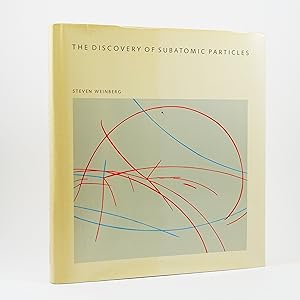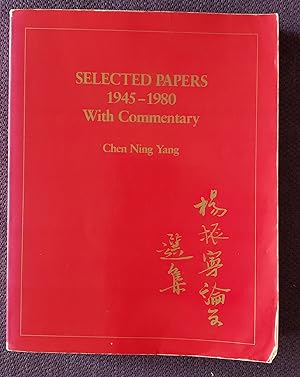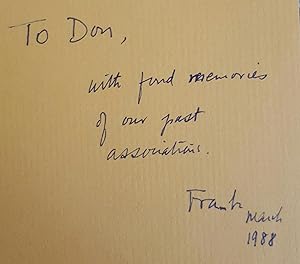san francisco w h freeman 1983 (7 results)
Product Type
- All Product Types
- Books (7)
- Magazines & Periodicals
- Comics
- Sheet Music
- Art, Prints & Posters
- Photographs
- Maps
- Manuscripts & Paper Collectibles
Condition
Binding
Collectible Attributes
Free Shipping
- Free US Shipping
Seller Location
Seller Rating
-
Ancient South Americans
Published by W. H. Freeman and Company, (1983)., San Francisco, 1983
Seller: D. Richards, Bookman, Pittsburgh, PA, U.S.A.
First Edition
Hardcover. First Edition. 414pp. Some pencilling, else a near fine copy. Size: 8vo - over 7¾" - 9¾" tall. Book.
-
PLANETS [Readings from Scientific American]
Published by W. H. Freeman and Company (1983), San Francisco, CA, 1983
ISBN 10: 071671468XISBN 13: 9780716714682
Book First Edition
Paperback. Condition: G/No Dustjacket. Black & White/Color Illus. (illustrator). First Printing. San Francisco, CA: W. H. Freeman and Company. G/No Dustjacket. (1983). First Printing. Paperback. 4to., 132 pp., rubbed, bumped .
-
Selected Papers 1945-1980 with Commentary.
Published by San Francisco: W. H. Freeman, 1983., 1983
ISBN 10: 0716714078ISBN 13: 9780716714071
Seller: Ted Kottler, Bookseller, Redondo Beach, CA, U.S.A.
Book First Edition
Hardcover. Condition: Very Good. No Jacket. 1st Edition. First Edition. xvi, 596 pp. Original cloth. Very Good. Chen Ning Yang: Nobel Prize, Physics, 1957 (shared with Tsung-Dao Lee), 'for their penetrating investigation of the so-called parity laws which has led to important discoveries regarding the elementary particles.'.
-
THE PLANETS [Scientific American] Foreword by Carl Sagan, sponsored by The Planetary Society
Published by San Francisco, W. H. Freeman and Company (1983), 1983
ISBN 10: 071671468XISBN 13: 9780716714682
Book
Broschur. Condition: Gut. 132 S., 28cm Zustand: illustrierter Einband berieben, gering bestoßen --- Inhalt: englischer Text. Umfangreich, teils farbig illustriert. The "Golden Decade" of planetary exploration vom 1971 to 1980 greatly increased our knowledge of the solar system. Summarizing the diverse and voluminous findings of this recent era, The Planets is a timely collection of ten articles from Scientific American written by leading physicists, astronomers, and geologists. KK-PS21-3R ISBN: 9780716714682 Sprache: Englisch Gewicht in Gramm: 400.
-
The Discovery of Subatomic Particles.
Published by New York & San Francisco Scientific American Library, an imprint of W. H. Freeman and Company 1983, 1983
Book First Edition
Quarto. Original blue cloth, titles to spine in silver, grey endpapers. With the dust jacket. Double-page frontispiece and illustrations throughout the text. An excellent copy the cloth and contents fresh in the jacket that is lightly toned with minor creasing and short splits at the edges, some scratches primarily affecting the upper panel, and a small dark spot on the illustration on the upper panel. First edition, first printing of this important popular history of particle physics by "the preeminent public intellectual of fundamental physics", Steven Weinberg (1933-2021) (Arkani-Hamad, "How Steven Weinberg Transformed Physics and Physicists, Quanta magazine, August 11, 2021). Uncommon in nice condition in the dust jacket. Weinberg was one of the most important physicists of the 20th and 21st centuries, and was awarded the 1979 Nobel Prize for the electroweak theory, which unified two of the fundamental forces: electromagnetism and the nuclear weak force. "Working separately, Dr. Abdus Salam, a Pakistani theoretical physicist, came to the same conclusions as Dr. Weinberg. Their model became known as the Weinberg-Salam Theory. It was revolutionary, not only for proposing the unification of the electromagnetic and weak forces, but also for creating a classification system of masses and charges for all fundamental particles, thereby forming the basis of the Standard Model, which includes all the forces except gravity" (New York Times obituary, July 29, 2021). "Though he had the respect, almost awe, of his colleagues for his scientific abilities and insights, he also possessed a rare ability among scientists to communicate and explain abstruse scientific ideas to the public. He was a sought-after speaker, and he wrote several popular books about science, notably The First Three Minutes: A Modern View of the Origin of the Universe (1977) (NYT). As Weinberg explains in the introduction, The Discovery of Subatomic Particles, "grew out of a course that I gave at Harvard in the spring of 1980. to engage students who were not assumed to have any prior training in mathematics or physics in learning about the great achievements of twentieth-century physics". It "covers the discovery of the fundamental particles that make up all ordinary atoms: the electron, the proton, and the neutron" and was written "for readers who may not be familiar with classical physics, but are willing to pick up enough of it as they go along to be able to understand the rich tangle of ideas and experiments that make up the history of twentieth century physics".
-
Selected Papers 1945-1980 with Commentary.
Published by San Francisco: W. H. Freeman, 1983., 1983
ISBN 10: 0716714078ISBN 13: 9780716714071
Seller: Ted Kottler, Bookseller, Redondo Beach, CA, U.S.A.
Book First Edition Signed
Soft cover. Condition: Very Good. No Jacket. 1st Edition. Original wrappers. Very Good. Inscribed 'To Nigel/from the author/Feb. 1984' by Yang on title page. Inscribed by Author(s).
-
Selected Papers 1945-1980 with Commentary. (INSCRIBED BY YANG TO FELLOW NOBEL LAUREATE IN PHYSICS DONALD GLASER.)
Published by San Francisco: W. H. Freeman, 1983., 1983
ISBN 10: 0716714078ISBN 13: 9780716714071
Seller: Ted Kottler, Bookseller, Redondo Beach, CA, U.S.A.
Book First Edition Signed
Hardcover. Condition: Near Fine. No Jacket. 1st Edition. First Edition. xvi, 596 pp. Original cloth. Near Fine. Inscribed: 'To Don/with fond memories/of our past/associations [see below]./Frank/March/1988'. The Nobel Prize in Physics 1957 was awarded jointly to Chen Ning Yang and Tsung-Dao (T.D.) Lee 'for their penetrating investigation of the so-called parity laws which has led to important discoveries regarding the elementary particles'. The Nobel Prize in Physics 1960 was awarded to Donald A. Glaser 'for the invention of the bubble chamber'. Yang (1922-) and Glaser (1926-2013) are two of the 11 youngest Nobel Laureates in the sciences, winning at ages 35 and 34, respectively. 'The general intuition is that as you go to less and less biological and simpler and simpler systems, you begin to lose the ability to distinguish time going forward and time backward. And that's an endless debate having to do with evolution and cosmic and so on. But that's the simple explanation of it. So everybody assumed that if you're talking about these little submicroscopic particles, that they don't have any knowledge of timeAnd the other question is that there are right-handed and left-handed people, there are even right and left handed molecules. Dextrose, for example, is a right-handed sugar, and levulose is the same thing exactly, but it's a mirror image. And so it is with the amino acids. They're all left-handed in our biology, but they don't need to be. If you make them synthetically, you get what's called a racemic mixturehalf are right-handed, half are left-handed. But if they come out of a biological process, they're all the same. So the notion was that as you get to simpler and simpler and less biological things, handedness also goes away. So you would think that, unlike a bowling ball, which has handedness because of the finger holesI guess, maybe not, I'm not sure about that. But anyhow, as you get to billiard balls, then they're symmetrical, and the fantasy was that these little particles are billiard balls. They can't tell if they're getting older or not. They're not right-handed, they're not left-handed and Lee and Yang, a couple of really smart guys at Columbia, said, 'You know, it's all very well that we have that intuition, but nobody's proved it, and it may be that these guys can tell if they're right-handed or left-handed.' To make a long story short, they were right that these particles do know if they're left-handed or right-handed, and there are different kinds. . . . There was a general belief, your well-trodden path, that as you go to simpler and simpler and therefore smaller and smaller physical objects, they will have simpler and simpler personalities. And handedness is one that's gone. Then Lee and Yang said, 'Hey, it ain't necessarily so. We assume that because it sort of seems appealing, but there's no proof of it. Furthermore, it could be that it isn't true.' What do you know, these little particles, the so-called strange particles, have handedness. That's called parity violation, and that's a Nobel Prize. That was a tremendous shock. But they pointed out that here we were following everybody on the same path, and going out in the shrubs, we found an interesting thing. So there are these people who are mavericks. They're not trying to destroy anything' (Donald A. Glaser, Ph.D., The Bubble Chamber, Bioengineering, Business Consulting, and Neurobiology: An Interview Conducted by Eric Vettel in 2003-2004, Program in Bioscience and Biotechnology Studies, Regional Oral History Office, The Bancroft Library, University of California, Berkeley). Signed by Author(s).



![Stock image for PLANETS [Readings from Scientific American] for sale by Riverow Bookshop](https://pictures.abebooks.com/isbn/9780716714682-us-300.jpg)

![Seller image for THE PLANETS [Scientific American] Foreword by Carl Sagan, sponsored by The Planetary Society for sale by Antiquariat Biebusch](https://pictures.abebooks.com/inventory/md/md31209430551.jpg)


